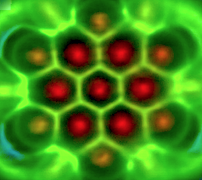It lacks continuity, symmetry and harmony.
In the Big Board-little universe model using base-2 notation from the Planck Time to the Age of the universe, the entire physical universe is contained within just over 200 notations that are highly-integrated and totally-predictive. Notations are also known as clusters, doublings, groups, sets or steps. Within the first second of the universe (between notations 143 and 144), there is more than enough “natural inflation” from the Planck Charge to get “things” going. As a result of studying and working with this model since December 2011, there are many-many facets to explore, however one of the most important is that this model logically suggests that time is derivative and that the finite and the infinite are perhaps best understood in terms of continuity, symmetry and harmony.1
Continuity. Though an unusual way to define infinity, even with quantum indeterminacy, continuity throughout the universe is the bedrock of science, logic, and rational thought. Numbers clarify this continuity. Carried out a billion places, the universe and its systems around us replicate day after day with utmost precision. Within this model, continuity is more fundamental than time; it begets time.

-
The complexity of a single molecule
Symmetry. The second face of the infinite is symmetry. Though so much of life is asymmetrical, the deepest examination of any physical thing begins to reveal deeper symmetries. Numbered relations define those symmetries and the universe appears to be tiled and tessellated deeply within every notation throughout the model. Here symmetry is more fundamental than space; it begets space.
Harmony. Speculating, it is hypostatized that two symmetries begin interacting within a notation and then across notations, and though possibly not quite perfect, the interaction of the symmetries perfects the moment for the observer or for the notations involved. Therefore, we have moments of perfection within our experiences of the universe.2
Our studies. At this point in our studies, there is not much more we can say about how the infinite defines the model and what the model says about the very nature of the infinite. These three insights, although reflective of the model, in part come out of a study of a moment of perfection in 1972,3 then from studies of the book, Finite and Infinite: A Philosophical Essay (Austin Farrer, Oxford, Dacre Press, Westminster, 1943), and from an application to a business model.4
These three qualities became the bedrock for our model of the universe and for discussions about the shared nature of the finite and infinite.
What difference does it make? First, it is a clear contrast to the nihilism of big bang cosmology. Building in strength and popularity over the past 30 years, that nihilism has had a lot to do the fraying of our little world. So much is out of control and spinning apart. Money is not the issue. What we believe and how we believe is. Hope is. Charity is. Integrity is.

What is 5000 to 13.8 billion years? The finite and infinite relation has been the focus of humanity for as long as we have been recording our ever-so-short history. In light of 13.8+ billion years, five thousand years of records is, of course, quite short. We’ve just begun to make sense of it all.
Today in history. The finite is usually associated with physical, limited things. The infinite is often capitalized and associated with godly things, the eternal and everlasting. To our knowledge, Max Tegmark is the first theoretical physicist who has suggested that the concept of the infinite be abandoned. His rationale is that it gets in the way. He cannot make it work for the science he wants to create. Within these many articles, we hope to convince him, Hawking, Guth and so many others to re-engage our simple definition of the infinite. It does not require a religion or religious beliefs. Notwithstanding, it also doesn’t fly in the face of those who believe in the Infinite.
We can all begin to tolerate each other.
This is our simple introduction to a very large topic and we will return to this page often to expand its range and its depth.
1 A general introduction was the prior homepage.
2 This construct was introduced within these pages at the end of the year, December 2015.
3 This construct goes back to work in 1972 at both Synectics Education Systems in Cambridge, Massachusetts and the Harvard Philomorphs with Arthur Loeb and Buckminster Fuller.
4 The original construct was used as the foundation of a business model for a weekly television series, Small Business School, that Bruce Camber and Hattie Bryant started in 1994. It aired on PBS-TV stations throughout the USA and on the Voice of America around the world for over 50 seasons (2012).
###